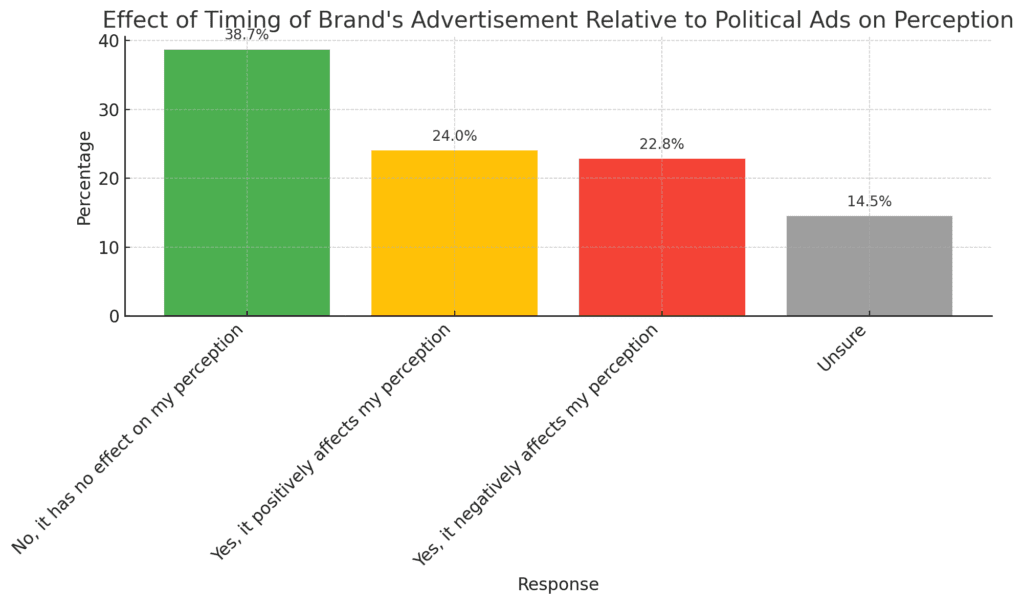How Ads During Political Season Shape Brand Perception
With political ads dominating every medium, how do you ensure your brand doesn’t just survive but thrives? Our snapshot survey conducted on 5/14/2024, and canvassed 517 adults 18+ throughout the United States, reveals how political ads impact viewers’ perceptions of subsequent non-political ads. These insights are not just eye-opening—they’re game-changing for marketing directors and CMOs aiming to optimize advertising strategies during political seasons.
Snapshot Survey Quick Summary
Platform Exposure: Traditional TV leads in political ad exposure, but YouTube and streaming services are catching up. Marketers should adopt a multi-platform approach.
Emotional Impact: Ads aligning with viewers’ political beliefs enhance brand perception; those opposing can harm it. Understanding audience political leanings is crucial.
Attention Dynamics: Political ads heighten emotional states, making viewers more receptive to subsequent ads. Strategies should account for varied viewer responses.
Trust and Tone: Negative political ads and frequent rotations can erode brand trust. Ads placed during neutral or positive breaks fare better.
Timing and Demographics: Ad timing has mixed effects; older individuals are less influenced by timing, while younger audiences are more divided. Tailored strategies for specific demographics are essential.
Key Findings On Advertising During Political Seasons
Where do people commonly encounter political ads?
TV: 44.1%
TV Streaming Services: 22.24%
YouTube: 24.18%
Radio: 5.42%
Digital Audio (podcasts, online radio): 4.06%
Impact of Political Ads on Subsequent Non-Political Ads
After viewing a political ad that aligns with their views:
Enhances perception positively: 26.69%
Affects perception negatively: 15.47%
No significant influence: 48.94%
Unsure: 8.90%
After viewing a political ad that opposes their views:
Enhances perception positively: 23.02%
Affects perception negatively: 24.56%
No significant influence: 40.23%
Unsure: 12.19%
Attentiveness to Non-Political Ads After Political Ads:
More attentive: 26.31%
Less attentive: 24.95%
No change: 39.85%
Unsure: 8.90%
Tone of Political Ads and Reception of Next Commercial’s Message
Positively affects: 22.82%
Negatively affects: 21.28%
No effect: 40.23%
Unsure: 15.67%
Likelihood to Purchase Product/Service After Political Ad
Much more likely: 18.96%
Somewhat more likely: 14.70%
Somewhat less likely: 15.86%
Much less likely: 13.73%
No difference: 36.75%
Timing of Brand’s Advertisement in Relation to Political Ads
Positively affects perception: 23.98%
Negatively affects perception: 22.82%
No effect: 38.68%
Unsure: 14.51%
Trust in Brand With Heavy Rotation of Political Ads Around It
Increases trust: 22.44%
Decreases trust: 29.79%
No impact: 35.98%
Unsure: 11.80%
Interplay Between Political And Non-Political Ads
The Platform Matters: Traditional TV remains the king of political ad exposure. However, YouTube and streaming services are catching up fast. This shift signals a growing trend of digital consumption, offering new avenues for savvy marketers to explore.
Emotional Impact: Ads that align with viewers’ political beliefs tend to enhance the perception of subsequent brands. Conversely, ads that oppose their views can create a negative halo effect. The emotional context set by political ads can significantly color how your brand is perceived.
Attention Dynamics: Over a quarter of respondents become more attentive to non-political ads after watching a political ad. This suggests that the heightened emotional state from political content can make viewers more receptive to other messages—if done right.
Tone and Trust: The tone of political ads and the frequency of their rotation around your ads can impact brand trust. Negative political ads can sour the viewer’s mood, decreasing trust in your brand, while heavy political ad rotation tends to erode trust further.
Timing is Crucial: The timing of your ad relative to political ads can sway viewer perception. Ads placed in neutral or positive breaks are likely to be better received than those sandwiched between intense political content.

Advertising During Political Seasons: Timing and Gender Insights
Timing of Advertisement Relative to Political Ads:
No effect on perception: 38.7%
Positively affects perception: 24.0%
Negatively affects perception: 22.8%
Unsure: 14.5%
Effect of Subtle Political Messaging:
No change: 36.8%
More favorable: 27.3%
Less favorable: 22.2%
Unsure: 13.7%
Demographic Insights
Gender: Females generally have a higher percentage of respondents stating “No effect” on perception compared to males. Males are more likely to view commercials addressing the political climate favorably.
Age: Younger respondents (18-29) are more evenly split in their perceptions compared to older respondents who tend to have clearer opinions. Older age groups (45+) are less influenced by the timing of ads relative to political ads.
Conclusion: How Ads During Political Season Shape Brand Perception
The data from the Colling Media Snapshot Survey provides a compelling narrative about the intricate relationship between political and non-political advertising. The findings emphasize the necessity for marketers to be acutely aware of the environment in which ads are placed, particularly during politically charged periods.
Addendum Charts
